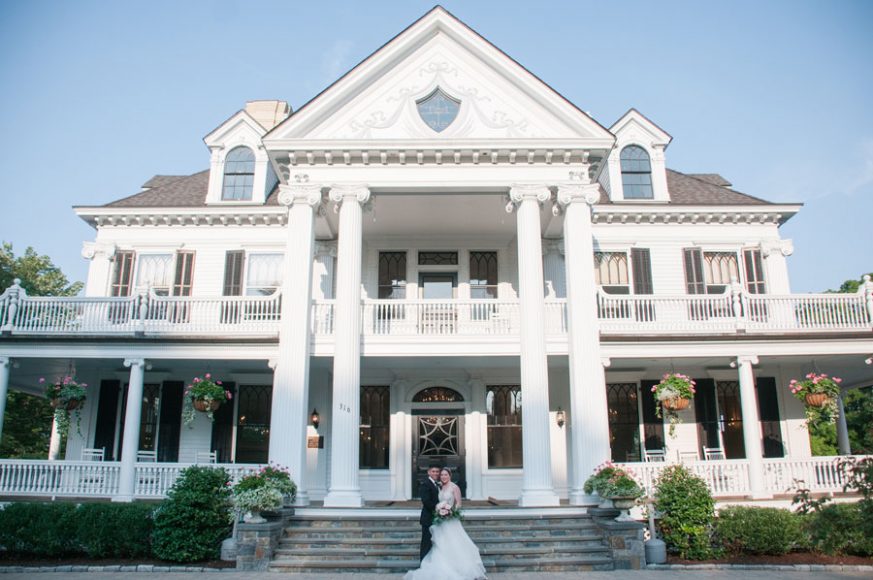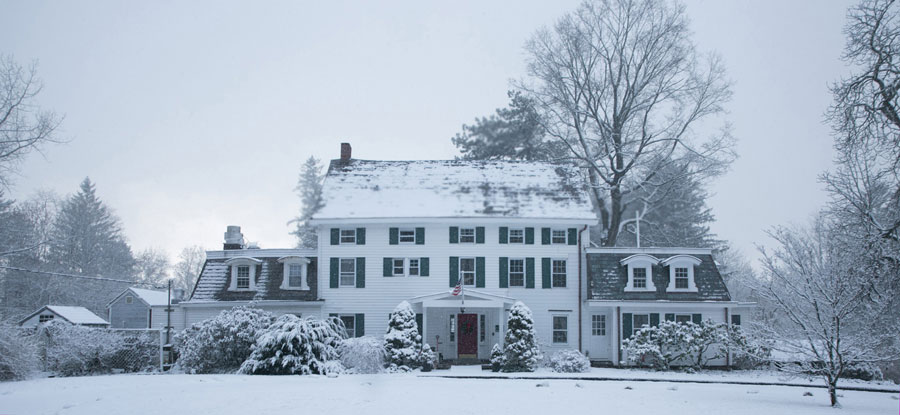A sweeping staircase, exquisite crown moldings and massive doors make for an impressive entrance at Lounsbury House in Ridgefield. But first impressions don’t start there.
The grand, neoclassical-style house looms large on Main Street with its tall Ionic support columns and 2-story portico framing the façade. When visitors walk the wide wraparound porch — one of two — period details reveal themselves. And by the time they settle into communal rooms that boast fireplaces, chandeliers, a grand piano and the house’s original stained glass window, the grandeur and feeling of importance have been transferred to their purpose in being there.
There’s no question that when a structure this finely crafted has been repurposed to serve an entire community, quality of life is enriched. For 60 years, Lounsbury House has been utilized as a community center and event space. So, whether it’s been booked for a lavish wedding or used for senior luncheons, a children’s Bunny Brunch or business meetings, the majesty and whispered history of the house exalts the experience and functions become more than just functional.
Originally built in 1896 by Gov. Phineas Chapman Lounsbury, the house is an example of the potential that historic structures can fulfill once restored, preserved and adaptively reused.
“A lot of people who have grown up here feel it connects them with their roots,” says Suzanne Brennan, executive director of the house.
To replicate such efforts in other towns and cities, myriad of entities need to recognize the value these structures can have, not just aesthetically, but economically.
In the case of Lounsbury House, mounting costs of care and restoration are mitigated through event rentals, membership dues and fundraising. Placing importance on historic preservation has served Ridgefield well. Commerce is in part driven by visitors who are in turn drawn to the town’s charm and quality of life. This beneficial economic aspect of historic preservation is an important piece of an argument that’s gaining headway.
But re-education is another critical component. In Yorktown, an area rich in history (especially related to Colonial times and the Revolutionary War), preserving historic structures is a priority. This is evident by the town motto, “Progress with Preservation.”
To reinforce that ethos, the Yorktown Landmarks Preservation Commission (YLPC) will be holding a workshop on May 8 focusing on its disappearing architectural history. The symposium will review some of the treasures that were lost to modern development, how its legacy stands today and attempt to dispel the misconceptions of preservation.
For example, many historic homes were built to house multiple families and uses, making them viable to repurpose as affordable or luxury housing. It’s possible to increase population density and create housing while still protecting moderate size structures, not building ever skyward.
At the Yorktown symposium, a network of municipal and state personnel as well as developers, real estate agents, civic leaders, educators, property owners and the general public will hear examples of historic preservation’s contribution to economic growth.
Unfortunately, before the benefits of preservation were as recognized as they are today, large swaths of the town’s legacy were demolished. The area of Yorktown Heights’ 19th-century commercial hub was largely torn down. And one of the most preserved Main streets in Westchester (in the hamlet of Shrub Oak) had its historic district declaration removed.
But more and more people, especially millennials, are making economic choices based on aesthetic appreciation and the comfort of nostalgia. They are choosing to frequent businesses housed in historic districts, proving character and charm do resonate and keep property values strong.
Of course, the battle rages on in the world of business and urban planning. Recently headlining the news is the Strand Bookstore in Manhattan’s East Village. Its owners are fighting a proposed landmark designation. Things like cumbersome paperwork and onerous renovation demands can be a deterrent. But in many cases, those limitations on business are often overstated.
An important argument on the part of hesitant business owners, however, is the lack of protection for the business itself. Landmark designation helps only to preserve the structure, not the type of business it houses. The compensation and incentive for small-business owners are just not there. It can be an unfair disadvantage compared with, say, the (close to $3 billion) incentive that a company like Amazon, a direct Strand competitor, was to receive before its move to Queens was quashed. Historic buildings can indeed elevate the culture of the business. But if the business is not protected too, it could suffocate.
Still, it’s been evident that historic architecture can fuel a community’s perception of itself.
That lesson reached public consciousness after the destruction of the Roxy Theatre and demolition and modern reconstruction of Pennsylvania Station, both in Manhattan. Such losses gave rise to the modern historic preservation movement in 1965.
The destruction of these grand temples of commerce did more than deal an aesthetic blow. It altered the psychological health of the community at large. As the late architecture historian Vincent Scully put it, “One entered the city like a god. One scuttles in now like a rat.”
But out of their ashes came the preservation of their great rivals — Radio City Music Hall and Grand Central Terminal. The celebration of these grand structures has become another important tool in the effort to reinforce their importance to an area.
In that spirit, the Greenwich Historical Society will hold its annual Landmarks Recognition Program April 28. Four properties will be recognized as examples of Greenwich’s unique architectural legacy. They will include The Greenwich Town Hall, The World War I Memorial on Greenwich Avenue, and other early 20th-century structures representing architectural styles such as Georgian Revival, Egyptian Revival and Tudor.
Grand architecture should, at its essence, feel timeless, outlast trends and serve as useful, flexible space. Paradoxically — yet equally important — it should be a structural expression of both the time and space it was constructed, a tangible reminder of a city’s past yet a continuation of its character. This connects us to our geography, to those who came before us — and those who will come after us — while architectural craftsmanship speaks to what we’re capable of as a people.
Historic structures herald a future not only grounded in an identity forged over centuries, but one that can be critical to economic progress.
History tells us that the wrecking ball should not be the first tool in our arsenal and true progress accommodates the past.
For more, visit lounsburyhouse.org, yorktownny.org and greenwichhistory.org.






